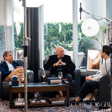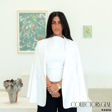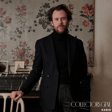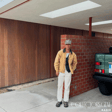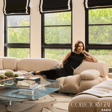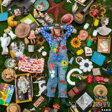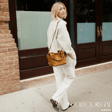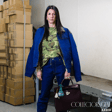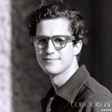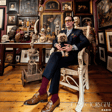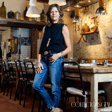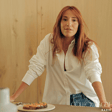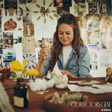Introduction and Creative Perspectives
00:00:00
Speaker
It's tuning into what are the things that make you tick and that really like speak to you, those so core elements. and I think when you're when you pull back from that, that allows you to understand what it is that defines your creative point of view.
Exploring the Collector's Gene
00:00:15
Speaker
What's going on, everybody? and Welcome to Collector's Gene Radio. This is all about diving into the nuances of collecting and ultimately finding out whether or not our guests have what we like to call the collector's gene.
00:00:28
Speaker
If you have the time, please subscribe and leave a review. It truly helps. Thanks a bunch for listening, and please enjoy today's guest on Collector's Gene Radio.
Interview with Josh Young
00:00:39
Speaker
Sitting down with me today is artist and designer Josh Young. Josh's new book Artful Home just launched, and it's a masterclass in authenticity. He's been collecting and curating since he was five years old, and growing up next to a small auction house didn't hurt either.
00:00:53
Speaker
After studying art and Milan, Josh garnered the art of mixing old and new. His neoclassical meets contemporary portraiture became widely known to collectors and designers, forging a path to work with some of the biggest names in the industry. Josh's collections range from multiple different categories, but they all have one thing in common, cohesiveness.
Josh's Artistic Background and Influences
00:01:11
Speaker
So without further ado, this is Josh Young for Collectors Gene Radio.
00:01:19
Speaker
Josh, welcome to Collectors Gene Radio. Hey there, thank you so much. I appreciate you having me. My pleasure. So first off, congrats on your new book. I'd be remiss if it's not the first thing that we talk about because I've personally loved looking through it and getting inspiration. I've already redone things in my home to ah try and mimic some of the ah the aesthetic that that you've portrayed in there. And I know you're on your book tour right now, so you're exhausted. So I do appreciate you coming on the show.
00:01:45
Speaker
No, thank you so much. it's I appreciate that. And it's a labor of love. It's a project I've been working on for a few years now, but it's ah it's it's fun and also a bit surreal that it's finally out there. And it's um it's really cool to kind of get the feedback from either people that have collected my work or people who are just being introduced to my work. It's been a really fun process, especially now that we're on this book tour. But um again, thank you for having me.
00:02:12
Speaker
Yeah, of course. And it's a momentous occasion, no doubt. And as an artist and a designer, this all kind of started for you quite a bit ago. You mentioned in your book that you used to curate your bedroom at home when you were a child. I mean, what kind of things were you collecting and putting in your room as a kid?
00:02:29
Speaker
Yeah, for sure. So, I mean, truly, i could I could, as I write in the book, I can stem it all the way back to probably when I was about five years old. I've just always been someone that has been drawn to beautiful objects, beautiful things, and even at large, more so, just surrounding myself and creating an environment that you know exuded a certain type of feeling. right Not only for myself, but for those that are within my spaces.
The Impact of Auction Houses on Josh's Art
00:02:59
Speaker
i write as ah as As a kid, in my childhood bedroom, like there were periods where I was either obsessed with or had fascinations with Paris, or I had a fascination with
00:03:10
Speaker
the 60s, literally, like it it runs the gamut, but I would try to create these environments. And of course, those environments in my room would also include pieces that would be relative to whatever whatever the theme is, du jour. Right.
00:03:29
Speaker
But it stems all the way back from that. And, you know, I grew up in a very small town in northeastern Pennsylvania. Actually, I grew up right out back of an auction house. And that really was a part of my upbringing. Like every Tuesday and Thursday we were at the auctions. And I think just as a kid being surrounded by you know, historic pieces and, you know, getting to interact with dealers from all over the Northeast, you know, it's impressionable, right? Like that that really that whole act of, and my parents were to an extent collectors as well, having an appreciation in understanding the intention.
00:04:08
Speaker
of incorporating things that you're drawn to or things that pique your interest, like that whole art of or that whole act of collecting has really been a part of me, truly like like I said, since the time I was probably five years old.
Nostalgia and Curating Spaces
00:04:24
Speaker
Man, to be five but to have the knowledge that you have now and live behind an auction house would have been insane.
00:04:32
Speaker
Yeah, and you know, it was nothing like it was nothing fancy or crazy. It was truly like an old, old barn that had been converted. And again, we had, you know, there was dealers from Massachusetts or upstate New York or other parts of, you know, in Philadelphia that would come up and it was a weekly thing. But You know, again, just walking those back rooms, right, where a lot of the pieces were kind of stored and just, you know, I've i've always, I was an only child growing up and I've always kind of lived in my head and I've always had to kind of like self entertain, but I would like,
00:05:06
Speaker
I would walk those aisles and just tactically and tangibly just like touching the pieces and understanding like the imperfections and the age of things. Like there was a mystique behind it. There was something that I found almost like I would create my own storytelling of like what these pieces were, where they came from, how old they were. I don't know. Again, there's something, there's there's like a nostalgia quality.
00:05:29
Speaker
for me, at least, like the the the act of collecting. I just, again, growing up with it and seeing my parents do it and the intention behind it.
Milan's Influence on Josh's Art
00:05:38
Speaker
Well, it makes sense because, you know, the things that you collect today, they range from anti-portraiture, hurricanes, miniature lamps, which are I find very difficult to find, old photographs, silver trays, vintage books on art and design. I mean, that's definitely things that you probably would have seen at this auction house because you know you're in these rural areas of of the East Coast and there's a lot of colonial influence there. Did that interest you as a child?
00:06:09
Speaker
Oh, for sure. I mean, again, like you can still you can still see those elements sprinkled throughout our homes. But you know whether we're dealing with you know Queen Anne furniture or 18th, 19th century pieces, I was surrounded by that growing up. Now, of course, like the mix is incorporating those pieces into our home with more modern elements just to keep it current. or you know to add tension or juxtaposition. But, yeah again, you kind of hit it. Like, those were very early references that I was exposed to and that I kind of latched onto. I mean, oddly enough, like, one of the chapters in the book is called Nostalgia. I think, like, incorporating those types of pieces from those periods, like, of course, there's a nostalgia quality to it, but it kind of, like, grounds me and it grounds my spaces to my roots.
00:07:03
Speaker
Yeah, you know, the nostalgia thing is interesting because I've spoken to people on here before and a lot of times they say they try and avoid nostalgia because it can get to the point where you almost lose the curated, ah collected aspect of what you're trying to do because if you're just harkening back to, it you know, when you were a kid and and the things that you remember, sometimes it's really hard to do in the right way and I think that That's something that you have mastered is you know the the nostalgia collected curated feel because i mean i mean it's just evident in your book that you've been able to to garner that.
Redefining Nostalgia in Art
00:07:42
Speaker
Well, and I think it's a redefinition, at least for me, of what nostalgia is, right? Like it definitely has always had this like negative connotation of being like stuck in the past or like some, you know, mishapish stuff. um But for me, a lot of it has to do with again, reckoning back to a a warm feeling, a good memory, something that, again, I have like fondness for. And it's not you know surrounding myself in a time capsule as much as it's just having those, for me, what are timeless, classic kind of pieces incorporated into newer things that I'm interested in or wanting to collect or you know discovering. But there's a sense of,
00:08:27
Speaker
you know, within the spaces that I like to create and reference the nostalgia. Like, again, it's just, it's it's kind of like enveloping myself with this feeling of warmth or playfulness or a nod to like yesterday, but it's not too literal. So, again, to each his own, but for sure.
00:08:49
Speaker
So you went to school in Milan for art and as an artist designer and a collector of many things. I'd love to know what stuck with you about Italy because it's such a special place that you feel is reflected in the things that you collect today or maybe the design practices.
00:09:06
Speaker
Yeah, for sure. and And for me, I mean, it was really in a lot of ways that can jump off point. So again, having born and raised in Pennsylvania, growing up, never left the time zone. Like, truly, we never really
Milan as a Design Influence
00:09:22
Speaker
traveled or anything. And at 19,
00:09:24
Speaker
I was just itching to get out. And it's ah I mean, it's a very long story, but I wound it up in Milan and enrolled in a university there and had subsequently lived there for six years. And the cool thing about it, at least for me, was it was obviously in a total contrast from where I grew up and what I was exposed to early on, right? Like the thing I loved about Milan and how it really influenced my work both on and off the canvas is It's a city, truly a city of juxtaposition. Yeah, it's a classic Italian city, but to have visited Milan or to know Milan is it's nothing like the cities of Florence or Rome. It's a true industrial happening type city. There's a pulse, there's a beat, there's grit. And that marriage of tomorrow,
00:10:18
Speaker
and yesterday kind of converged there. And, you know, I always used to think this too, even as a teenager, there's like, whether it be your design capitals or your fashion capitals of Paris, London, New York, Milan is really the only one of those cities where the entire city literally revolves around design.
00:10:38
Speaker
Like there's they're sure you have like a financial sector, but nothing like the other. I mean, if you're in Milan, like 90% of the people that you will meet somehow have some incorporation with working within either the fashion industry or the design industry.
Josh's Neoclassical Portraits
00:10:53
Speaker
So it's tangible there.
00:10:55
Speaker
And again, being exposed to that at a really young age, a coming of age, really, it definitely formed my eye and then definitely influenced like the way that I approach work. um And it was just a it was it was such an influential chapter for me.
00:11:14
Speaker
Yeah, and it makes sense because, you know, you have your portrait series, which features these neoclassical esque portraits, usually with a bright color slash through the middle of the painting. And it really is this mix of old and new. And as a collector, you obviously had a vision for how you would style these and collect these works because you've displayed them in your home as so. But how do you hope that others collect them? Because people do collect your work.
00:11:42
Speaker
Yeah, and I mean, I think like that that's the fun part is that it's open for interpretation. Especially with like the portraits, how that all started was, I've always had this fascination with portraiture. Truly since I was a kid, but when I was living in Milan, I would go to some of these antique and flea markets on the Nabili, and they would have these dealers, and they would have these, you know, over there, they're not as, I would say, like, precious, if you would, here in the U.S., because you can pick them up for rather cheap. but um And, you know, it was really just like kind of like applying and in having fun with more like abstract elements on top of them or behind them and just really kind of like shape-shifting or altering their structure or even how you view them. And I would put them up in our apartment and I would notice I guess we would have dinner parties or have friends over or
00:12:37
Speaker
you know, whatever, people would always gravitate towards those. So that's really how that whole collection kind of started.
Sharing Art with Collectors
00:12:44
Speaker
And over time, it's it's it's actually been really cool because The fun thing with my career as an artist and actually that I find rewarding is is you know I've had the privilege of having some really great collectors, right some really great people in the interior design space that have used my work in their homes and in the projects.
00:13:10
Speaker
But I've also met is like even on this book tour, like just people that have incorporated small elements of my work in their living rooms, in their studio apartments. like It runs the gamut and I love that. I love that how different people view my work and how they notice elements and things about my work that maybe I didn't even you know initially or conceptually like set out to to implement. But that within itself has been really, really cool. And the fact that even people collect my work is like, it's crazy for me. Like, that's so cool. It's impressive for sure. And I think you know the interesting thing is I too have i've always been interested and drawn to you know portraiture and and all that sort of stuff. it's always Every time I go into a gallery, it's it's where I go first. ah Or an art museum, it's always where my eye is drawn first.
00:14:05
Speaker
But it's not for everybody and you turning them into this like, you know modern version of it with these bright color slashes through it. I mean, it's it's pretty I mean genius. Well, thank you. But there's I there's like this mystique with them. I think it's so cool. Like for me again, like obviously there was not photography back then but it is like a look into the past of someone that No, usually no one has like any idea of who they are. Right. And, you know, I just latch onto their eyes and I've always been drawn to the portraits that are actually the most like simple in form and palette and, you know, nothing too elaborate within their, their clothing or attire.
00:14:45
Speaker
But i I do, I mean, i'm i'm I'm literally sitting here doing this podcast and as I like pan my living room, I'm looking at like five of them. um They freak some people out, ah but I just, I don't know, like I just have always found them to be cheeky or intriguing. Again, I think it's like the whole like storytelling that you can create for yourself about them that I find fun.
Portraiture as Storytelling
00:15:10
Speaker
Yeah, absolutely. i'm I'm with you there because, you know, sometimes you do go to these museums and galleries and you see portraiture and they are in these super elaborate outfits. And that obviously tells you a story of, of something else, but the ones that are simple, where it's just someone dressed up, you know, elegantly, usually with like some sort of bow tie. Um, and it, and it really is a focus on the details of their face. It's, it's such an interesting juxtaposition. Totally. 100%.
00:15:39
Speaker
So you've mentioned that your foray into interior design was a bit accidental, if you will. you know You posted a picture of your art and everyone said, hold on
Josh's Interior Design Journey
00:15:49
Speaker
just a second. Let's see what else is inside this house because it's obviously framed by the antiques. The art was being framed by the antiques as well.
00:15:59
Speaker
How does this affect the way that you collect things? Because before you were collecting for yourself and now you've made this jump into design and now you have to manage that and collect for others.
00:16:10
Speaker
Yeah, I mean, it actually didn't change anything. And the story is funny. I mean, truly, it it all happened accidentally. I was just sharing new pieces or new collections that I created and whether it be like hanging it up on a wall or setting it on a dresser that I had to do like angled or detailed shots. Like people specifically on social media were like noticing the background of the vignette that I was doing it within. And they're like, wait a minute. They're like, yeah, can you pull back? Or like, oh, I love that, you know, whatever it may be.
00:16:40
Speaker
Console table and slowly like the photos would just go from like very close and then I would start panning out a little bit more and then I would pan out a little bit more to the point where you could almost like see the whole room and it's fun because.
00:16:52
Speaker
like the two demographics kind of like merge as far as those that are clients or those that are followers of mine, you know, you have those that are really attached to our homes and my interiors, and then you have those that are specifically like collectors of my art, and they've kind of like merged and have become like synonymous with one another. But again, and that's the whole point of my book, Art for Home is, you know, as an artist,
00:17:22
Speaker
you know I live, breathe, eat, sleep, all of this. like There's a through line between the way that I live and my homes and my work and my studio. That to me, for me, as is like really natural. and Whether or not it's seen on camera or shown on you know the web or social media, like it's still the way that I would live. It's still the way that I would collect. It's still the way that I would style the spaces that I live within, how I did it when I was five years old.
00:17:50
Speaker
It feels pretty natural. I mean, it it it totally makes sense. It feels like a natural, ah not transition because it's just ah an arm of what you do, but it feels like a cohesive next foray and into what you have going on.
00:18:06
Speaker
Yeah, and and again, I think I've just always been someone that, you know, no matter what it is, like I have product collaborations that are coming out this fall. And it's funny because, you know, whether it's a room or obviously like everything to me is like a blank canvas. And I kind of approach each composition the same way in the way that I design or the way that I'm implementing different elements. um It's all one and the same for me. So yeah.
00:18:33
Speaker
The thing that I love about what you collect is that, you know, you can never really have enough. There's always a space that you can use all those items, whether it's yours or someone else's home, you know, hurricanes and miniature lamps and, you know, julep cups and all that stuff. I mean, is that part of the fun for you that there is never a shortage of this stuff to find and you can subsequently always find a home for it?
00:18:58
Speaker
Oh, for sure. And I'm definitely that person. My husband always wants to kill me. But it's like if I latch on to something, like there will be room. And I would be lying if I said we do not have like ah a storage unit in one of our homes where it's it's true. like I need a yard sale, for sure. But it's it's just sometimes when I am sourcing or I'm shopping and there's something that just catches my eye and I i just fall like head over heels for it, I may not initially have a spot or space for it, but it's coming home.
00:19:27
Speaker
And it's just that. It's just that that thrill and that love of like running into something that just speaks to you and that excitement. Right. And I think too, because I'm not I'm not very rigid with the way that I design and the way that I set up rooms that, you know,
00:19:46
Speaker
If something doesn't work here, I'm sure there's another space where this would work or we'll and it we swap out and change. like It's fluid. And I think um not being so strict in that makes collecting fun. Yeah, no doubt. and And the other thing I love is that you don't always have to be after something rare with any of those things. Sure, you know they have their time and place, but it's more design focused and sometimes the best buys are 25, 50, 100 bucks. 100%.
00:20:13
Speaker
i'd like People always shit when they come in my house and like, oh my god, I love this. This is so amazing. This must have been so expensive. I'm like Literally $250 and it's because of that. Like I have I do have a deep appreciation obviously for Rare historic meaningful provenance type things but at the same time again just with the way that my brain works, with my eye works. It's like, if it's beautiful and I fall in love with its form and design, I don't really care if it's, you know. A $10 find or a $250 find. Or if it's a mass market produced. I like what I like. I don't try this kind of, again, restrict myself in that type of headspace. Right. I mean, Ralph Lauren hurricanes are undeniable.
00:21:01
Speaker
Yeah, and I just like, again, there's something to be said just about like, beautiful, good design. And I think it's the mix too, right? they sure Like for me, the and I can think of a lot of homes I've been in that just like, either really spoke to me or very memorable or impressionable. And it's always been those homes that I hate to say like high and low, but it's it's it's truly those people and those collectors that are able to do that mix and pull off that mix so effortlessly. And it's very like relatable too, right? like I'm not trying to live in the museum, personally. Right. You want to be able to use everything.
00:21:36
Speaker
Yeah, they have their special pieces, but albeit artwork or, again, you know objects that are that are have some historical or you know significance that they got at auction. But then there's also two like things they found on Facebook Marketplace or they things they found at a flea market that are just like, wow, what a great find. And that and marrying the two is really, I think, like that that within itself is such an art. Yeah, for sure.
00:22:02
Speaker
And I mentioned earlier, but one thing that I found a bit more scarce are miniature lamps. And I know that this is something that you collect because most lamps are so large and they take up so much space and they do have their time and place. And when they make sense in a room, but it's really hard to find small scale lamps. And I've noticed that most of your miniature lamps have this glass blade, a glass of vase and sorry, glass base that blends in with the room. And it's really about the lampshade. Is that the idea there?
00:22:32
Speaker
Yeah, and I mean, the the thing I love about, I mean, it sounds so silly, but it usually is something that people notice when they walk into my spaces, because each room probably has at least one. But, you know, smaller miniature lamps, I love the versatility bit that they add. To your point, I think that they're hard to find. And I think that they're really, they're They're practical, but they're there's they're fun little elements to add into different vignettes. But the crystal based ones that you're referring to are actually from Visual Comfort. And I i probably only 15 of them.
00:23:11
Speaker
um And they're fun because I can swap out the lampshade, right? Like they're so versatile because they are crystal. um They can really work within any space and you know whether it's adding them to the top of my mantles or putting them, I'm sitting in my dining room right now and we have like this china cabinet and we had one wired within it so that at night it can kind of show off my collection of like porcelain and you know Again, it's that versatility of use. And I have always noted that when we're shopping or sourcing, like if i say if I see a small little lamp, like I will gravitate towards that thing like none other. Yeah, I just i just posted a video a couple of weeks ago. I found these Italian Fontana Arte really small lamps. And I was just so excited to find them because it's so difficult for me to find these miniature lamps. And when I saw them, I had to i had to grab them. Oh, no, for sure. and
00:24:05
Speaker
You know, I have this fascination with like small trays or usually it's just things that can work within any space or environment. Right. Packing a big punch of small design. Yeah. 100% that I know that I've always been that way. I mean, again, my husband laughs at me all the time, but.
00:24:24
Speaker
you know, whether it be clothing or sourcing for antiques. Like if I buy something, I'm going to use it. I'm not, I'm usually not one to just like latch onto something and not have a use for it. So yeah. Right. So you've been featured in a million different publications and on a different bunch of different projects. And I'd be remiss if I didn't name as many as possible. So architectural digest Oprah magazine, you've worked with Nate Berkus and Christian Siriano.
00:24:50
Speaker
You've done work at the Bulgari Hotel in London, the Draper Hotel in New York, ah William Sonoma, One King's Lane, just to name a few. How do you feel that working with these people and these brands and these projects have shaped the collector that you are today?
00:25:05
Speaker
well The honest answer is they haven't. Again, I've always been someone that's always trying to really stay true to my own point of view um and not have too much outside influence. It's it's funny, like the amount of times we get hit up for like a trend piece, my usual response to a publication is like, I'm not writing this. I am not your guy. Again, like I've always been someone that... Again, if if there's if there's a quote unquote trend that there's there's certain elements that maybe you want to try out or incorporate, I think it's fine. But i think I think it's very wasteful to just kind of lean into that. And also too, I think it's such a loss of personal style, right? Like for me, tuning out a lot of that noise
00:25:48
Speaker
is really, and again, that's that's truly what the book is about, right? Like all of those chapters, whether it be forum, nostalgia, palette, it's it's tuning into what are the things that make you tick and that really like speak to you, those core elements. And I think when you're when you pull back from that, that allows you to understand what it is that defines your creative point of view, right? Like I always say, like the coolest thing for me is whether it be online or in a magazine or, you know, sometimes people will come across my work and they'll be like, Hey, like I noticed you weren't credited for this, but I knew it was yours. And I think it's, it's because there's that implementation of, of, of those core things that again, are not influenced from the outside world or people that I've worked with or it's me.
00:26:35
Speaker
And I also think, too, just because of having that really strong sense of self and, again, a strong point of view, that's why brands have reached out. I think that's why certain interior designers, like my work speaks to them. it's it's There's a ah level of authenticity and like unapologetic about it, too, um regardless of where trends go. like i just not if and i I evolve, i'll I'll definitely change. But there are certain things that I'm pretty staunch on like remaining the same and true to to to myself as an artist and as a creative. Yeah, and I think that that's pretty evident in all your photos and and in your book, right? Like
00:27:23
Speaker
Your townhouse and your country home could easily be the same place if if someone didn't know that it was in two different locations, right? um Obviously they have slight differences, but they're collected and curated the same.
00:27:37
Speaker
Sure, definitely. And I mean, the process of Sycamore House, our country home, was was fun because, you know, I did, i did the townhouse is our primary. So this is where we spend all of our time and, you know, it's in the city. So there's there's a certain level of like practicality that that the space still needs to uphold, where Sycamore House was you know That's where we spend holidays and weekends and gatherings, and I wanted to be a little bit more playful, not only with like the objects that i'm I incorporated into the space itself, but you know leaning in a bit more with color and with some pattern, really allowing myself to be a bit more unrestricted, but again, having the same approach to how I would put together any space.
00:28:22
Speaker
But yeah, and and again, just like I've just always been someone that I love to surround myself with things that I love. And I think that there... It's not only meaningful to me, but there's like even just as someone who loves to entertain and to host, just having people over and just having everything literally being like a conversation piece or a jump off, it's fun. it's It's fun because again, everything that collectors like us, right, like we know, there's so much intention behind what it is that we incorporate into our homes.
00:28:59
Speaker
And again, having others like see that as ah as a true like art form within itself is is is cool. So I would have to imagine that the new branded products and and collaborations that you have coming out are very, very ah influenced by your taste and your design and what you collect. 100%. It's funny. Some of the pieces that you that you listed of things that I love will be and included too. um That's great. Yes, 100%.
00:29:29
Speaker
Can't wait for that. Is there any release date that you could share on that, on that stuff? Yes. So my, and I'm actually like, this is also very me. Like, let me pull up my calendar, make sure this has helped me with this. She's always like, remind me of everything. Yeah. So I have a product collaboration. It's a multi-year product collaboration that I'm super excited about. It comes out with Williams Sonoma Home.
00:29:50
Speaker
and that launches on Tuesday, October 1st. And this first collection is heavy with decorative accents and home goods from textiles like pillows to accessories like hurricanes, ah lamps, miniature lamps, um candles. I mean, it really runs the gamut, but there there are things that I've been working on for a very long time that, again, were super, super heavily inspired by.
00:30:19
Speaker
pieces that I collect, pieces that I've collected over time, antique pieces, things that I wish I could find but couldn't, so we designed it. And there's a holiday component too that will be coming out as well in October that I'm super stoked about. Can't wait. Thank you.
00:30:38
Speaker
For you, what's the connection between creating art or practicing interior design versus collecting it? Does it does it still have to remain you know this cohesive thing? Or are you willing to take on a design project if it's not necessarily the same way that you collect or that you design? That's a really good question. I mean, I think they're all, at least for me, right? like I think they're all related because the approach is the same.
00:31:05
Speaker
you know I always say like how I approach a canvas is is really, in a lot of ways, the same way that I approach a room. The focus on the elements that I'm incorporating, the forms, the palette, creating harmony within it. i mean that focus and that that kind of headspace is really, again, I think it all it all, all roads lead to like just that intention. It's nothing random. I always say like everything I do, there's nothing really random. That's not like just happenstance. Like there's so there's a lot of intention with the things that I that i that i do and that I incorporate within my spaces or that I create. There's thought behind it. And ah I think when going out and searching for
00:31:51
Speaker
a specific piece, right? like Let's say it's like something that I've been like coveting for a while and there's so many things to choose from. There's then such a like heavy attention to, at least for me, like again, like the form of the piece, the fragility of it, the artfulness of it, the the the scale of it. like That's just when I go into hyperdrive and like I'm picking out like the little minutias of things and hyperfocusing on making sure that whatever it is that I'm incorporating or bringing into my space, like it's it's not perfect, but it's it's exactly what i I envisioned and wanted. Yeah, absolutely. And I mentioned this earlier, but I noticed that your use of vintage julep cups for various things, you know vases, art supplies, et cetera, and this is obviously something that you collect a lot of
00:32:45
Speaker
Why do you feel that people sometimes or get stuck in their head that, I need a vase, I need to go find something that's you know very reminiscent of a vase, it's labeled as a vase, it can't be something else? Oh yeah, totally. Why why do people get stuck on this idea that you know they can't use something else to display what it is? Well again, i think it's I think it's just allowing, and I'm sure that that's applicable with me and other areas in life, right? Like we get in our own heads, and sometimes we just don't allow ourselves to It sounds cliche, but it's true. It's like, think outside the box. It's funny you brought up the the cups because I was just doing a signing at Rizzoli last week and the crowd got a crack out of, I literally brought one with me from D.C. because that's that's where i hold that's what I use to hold my Sharpies for my signing. It's like, I literally like carry it in my bag. It comes with me. like i don't want to use the like ah I don't want my pen sitting on it. like that has to ah And again, it's that through line of like, that's just me. That's the thing I like.
00:33:45
Speaker
I gravitate towards. But the second part of your question is, it's interesting because even in the book, like you'll see I've used latrines and I've used pictures and I've used random boxes to that I lined then with like waterproof whatever like to put flowers in. like i just I love sometimes using things that were not necessarily like intended to be used for X. For sure. I think that playfulness and I think that like sense of like unexpected use for something, it's fun, it's cool. It's like, oh, I never thought about that. Right. And I think that that's kind of my thought process is I love
00:34:30
Speaker
collecting something that I find important enough to bring home and spend money on and put in my house. And then someone um comes over and they're like, oh, that's interesting. I would have never thought to use that. Or why did you do that? And it's like, it's part of the story and you get to tell people about it. And it's not a flex, which is a cringy word, but it's not about that. It's more about doing something that you find to be creative and then explaining to someone and feeling, you know, the conviction because they understand it now.
00:34:58
Speaker
Totally, and partly, because I and know i've I've had it happen to me, but like, and the cool part about that is is, you know, sharing that with others, like that can influence or inspire someone else to kind of view something in a completely different way that they may not have previously thought of using something for, you know, whatever it may be. But yeah, I've always loved that, where I'll take a piece that's usually used for sad reason and just kind of like say like screw it let's play with like like again like let's just let's try to make this a base like i know it's not necessarily like intended for this or whatever whatever it may be right
00:35:40
Speaker
So I picked three items from various pages in your book. And I would love it if you could tell me something about them that you found special enough to collect for your home or to put in the book. um So the first one's on page 91. There's a collection of polo mallets in a beachcomber style basket. And it's something that I've gotten really into lately and started collecting myself. And I really find it to be a underrepresented area of collecting.
00:36:10
Speaker
Yeah, you know, it's so funny. It's like people are like, do play um I do not play polo. Me either. But I just think they're really cool and they're really fun. And again, the the neat thing is is like they really play into the whole vibe that I was trying to create with Sycamore House, right? Where, of course, it's like ah it's a country home and it's located in what's known as like Virginia's Hunt Country. But there's such a playfulness to them and they're all vintage and you know an important part of this house for me, even though it was like,
00:36:39
Speaker
truly a marathon. we we From the time that we purchased the house to the till we shot it for this book was was quite literally like four months. And I wanted to fill, it was so important for me to like fill this home with primarily like vintage and antique pieces. And I wanted the pieces that lived within the house to seem as if like there had been an owner there for generations. Like truly like a house that had just been passed down. and Right, and you bought it as is.
00:37:06
Speaker
Yeah. And again, like, these are just small, like my, where I like to live, where I get excitement is in like the small little details, right? Like the little things like this, like the politics, like just these really like unexpected, fun, playful things that I don't know, like maybe one would think to put, you know, in the entrance before the, before you lead into like the main living room. Like, I just love having these really I don't know, like fun object. Again, I think that the cool thing too is like, there's such like great conversation pieces. And they give specifically for this property and for this home, like again, this illusion that this home has been
00:37:51
Speaker
It's seen some stuff, right? Like it's had some people live in there, even though it's truly just me and my husband. But yeah, it goes into that whole thing of just collecting things that may appear odd or like whatever. But I just, I gravitate towards it. Love it. On page 103, there's a cow still life painting that hangs above a cellar door in the kitchen of Sycamore House. And it's just such a...
00:38:16
Speaker
It's such a statement. To me, it is such a piece that explains everything that that house is and and just that moment of being above a cellar door like that. I just found it so interesting. Well, thank you. And I think that this really goes back into like a whole thing of, I had no idea when I bought it, but like you know i was I gravitated towards this piece. We we found this actually and when we were antiquing down in Raleigh, North Carolina.
00:38:44
Speaker
um And I saw this at in the shop, and again, it was so playful. It seems so like exaggerated. And obviously, when you walk into our kitchen, it's it's usually the first thing that people comment on. Like, what the hell is that? um But... I later then found out like these are really like collectible fun pieces from like the 19th century and specifically in the UK and you know landowners and farmers wealthy farm farmers I should say would commission these pieces and exaggerate like the size of their ox or cows to give a sense of like status right um
00:39:27
Speaker
And there was actually, it was really interesting. Like there's a lot of like pieces and articles written about these these specific um paintings of these cows. But um again, i I bought it because I just loved it. Like I actually didn't even know if it was that old, but I just felt like it was,
00:39:48
Speaker
You know, it was a part of me that was like, if I got like a livestock painting and and it wasn't exaggerated, it would be almost too cliche to put it in our country home. Right, right yeah exactly. i needed It needed a little and needed a little edge, if you will, or something that was off with it in order for it to be mine.
00:40:06
Speaker
Yeah, for sure. And of course, if it's absolutely perfect right above that door, so it's like it was made for your house. It's super predictable. Yeah, it almost becomes super predictable. so And again, great the funny part is is truly if in on that same page, or I should say on the opposite page on 102, you can see like this little black door and that's the entrance. When you enter that that, that cow is truly like the first thing you see and it's so funny watching people's. Sometimes they'll but they'll make they'll make some lewd comments, but it's it's all in good fun and it's it's cool ah Reaction to it. I mean look it's it's uh, people could say what they want, but it's it's an undeniable piece. That's for sure Thanks. Thanks for noticing it The last thing I wanted to ask you about is it's actually more of a culmination question and that is you know How important is it for you to collect things that you can use and not have to be too precious with? you know
00:41:01
Speaker
It's really important for me, I've said this before, but I love beautiful things. I love surrounding myself with beautiful things. I love my spaces to come off as, you know, refined, but there has to be a practical sense of like, I live within these spaces. You know, I always joke about like how, you know, the majority of our rugs are natural fiber or the quite literally probably 80% of the upholstery that you see on our furniture is all performance.
00:41:30
Speaker
Like I have to live within these spaces. I don't want, I personally don't want, and I know I don't want my guests to feel like they're walking into a museum. Have I had pieces that were super valuable and super important to me break because of just whatever reason? Yes. But I don't like to surround myself with things that are too precious because it's just, it's almost like a, it's a point of like anxiety, right? And for me, like that that's not fun. That's not fun.
00:41:58
Speaker
Love it. Josh, let's wrap it up with the collector's dream rundown. You can answer these questions based on any of the things that you collect. Sound good? Sure. All right. What's the one that got away? I would say and i this is the, these are the things I was looking at for, I should say at 3 AM this morning was, um, I'm looking for like a pair of Swedish empire chandeliers for our bedroom. And they're so hard to find the perfect ones, specifically the scale and the size of them is like,
00:42:25
Speaker
Next to impossible, but I'm determined. I'm like literally a year in for looking for these things. so Well, I've, I've said this before on here, but we've put a lot of things that got away into the ether that have come back. So I'm i'm pressing for that for you. Oh, and the reason why that guy, I guess I never answered that. The reason why they got away is because a year ago I found the perfect pair.
00:42:46
Speaker
at auction online, and of course I just like, ah it must have been a busy day or whatever, it completely missed it, found out they only sold for $300. And if I go anywhere else, they're literally like 4,000. So truly, quite literally keeps me up at night, including last night, just trying to trying to find the perfect parents.
00:43:05
Speaker
I have a lot of those misses too for getting an auctions going on and things go for next to nothing. Yes. The on deck circle. So what's next for you in collecting maybe something else that you're hunting after or something you've gotten interested in lately? The chandeliers. But aside from the chandeliers, I think a bunch of things. you know like i'm i'm feeling the urge to switch out some things within our townhouse, some new pieces, you know a lot of the a lot of the things that live in here have been here since we moved in. and
00:43:39
Speaker
I think it's time to switch some things up, so. And so when you want to get rid of stuff, are you selling it? Are you putting it in a storage unit? How does that work for you? Do you hold on to things? So I'm a bit of a hoarder um in the sense that I not hoard in the sense that there's just stuff piled up, but I can usually find, especially if if there are pieces that are truly important to me and that I love, I probably won't sell them. I always have some space for something somewhere else.
00:44:08
Speaker
Or, I mean, even in the past, I've given some things to my parents just because, selfishly, I'm like, I want this to stay within the family because I'm sure I'm going to kill myself if I sell this thing. um Or said piece, so. Yep. How about the unobtainable? So this is something that's just too expensive, in a museum, private collection, complete unobtanium.
00:44:31
Speaker
I mean, my mind automatically obviously goes to art. So probably like a Rothko, right? Or a Warhol or an artist that I love and admire and just would like, can't even fathom having an original of. Yeah, makes sense. How about the page one rewrite? So if money was no object and you could collect anything else in the world besides furniture and antiques, what would it be? Probably real estate. Good answer.
00:44:56
Speaker
Yeah, I would say real estate and and in places that I love. um I've always been someone that like I love putting my money into things that I can experience and that I can like live within. And if money was not an issue with that, yeah, like truly. Let's go around the world and see if I want to have a home. I love it. How about the goat? Who's someone that you look up to in the collecting world or someone that you find to be a great collector?
00:45:24
Speaker
Um, actually the first one that comes to mind is the interior designer Thomas O'Brien. I love his work. I think he I've met him once and he's such an amazing person too. But he has just such a great eye and truly like a collector like there are videos on YouTube of his homes. And it's Amazing. Not only just how he layers and how he collects, but like how he finds half this stuff. um And everything has a story. And I love collectors like that, right? like there's like you can You can be in a room full of hundreds of objects and like you just like pinpoint something and they've got the story of where they got it, how they got it, how much they paid for it, why they wanted it, and they'll go down like a whole list. But I think he's such a great collector. Yeah, absolutely. The hunt or the ownership? Which one do you enjoy more?
00:46:14
Speaker
Both, I think both. um I think that, you know, there's definitely a sense, I'm sure so many people can relate to this, like you you hunt, you search, and there's this excitement, and then once you obtain, it's like, great, and what's next, right? Like there's that, but I think,
00:46:33
Speaker
both are super fun processes and definitely like i said like that once you actually obtain something and own it to be able to have it is cool too but the hunt the hunt is always fun again the process with anything like that's. Even putting together a home like i always say like that process but yeah i love the finished product but like the process within itself. Can be really really rewarding and exciting. Most importantly do you feel that you were born with the collectors team.
00:47:01
Speaker
Totally. Totally. Like I said, it's kind of in my genes and ah and it stems from my childhood and I probably will always be this way. But yes, definitely born with it. Amazing. Josh Young, thank you so much for coming on Collector's Gene Radio today. Congrats on the book and everything you have going on and we'll keep our eyes out for the product collabs coming out. Thank you so much for having me. I appreciate it.
00:47:24
Speaker
All right. That does it for this episode. Thank you all for listening to Collector's Gene Radio.

